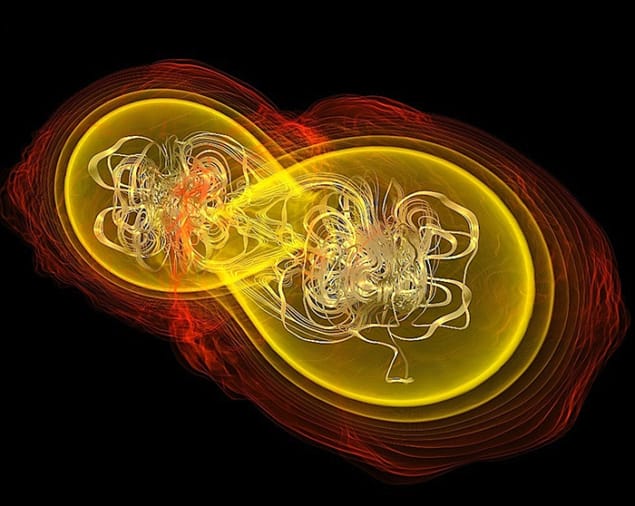
One of the many open questions raised by the first-ever gravitational-wave observation of a neutron-star merger is what happened to the two neutron stars in the aftermath – did they form a black hole or a neutron star, or both?
The gravitational-wave signal from the LIGO–Virgo detectors provides clear evidence that the merger involved two neutron stars with a combined mass of a small black hole. However, exactly how the two bodies joined together could not be observed because the frequency of the gravitational waves given off just before and during the merger were too high frequency to be seen in the detectors. Furthermore, there was no post-merger signal observed from the object created in the collision.
Four possible outcomes
There are four possible outcomes of the merger, according to Jim Hough of the University of Glasgow. One involves the two neutron stars merging to form another neutron star. Or a “hypermassive neutron star” could be formed, which would decay in less than a second into a black hole. The third option is the creation of a “supermassive neutron star” that decays into a black hole within a few hours. The final possibility is the direct formation of a black hole.
The merger produced a gamma-ray burst that is associated with the formation of a powerful jet of material being ejected from the merged object. Unfortunately, this does not narrow the options, according to Francesco Pannarale of Cardiff University, because such a jet could be formed by either a black hole or a rapidly spinning neutron star. “It’s not clear cut which one we have seen,” says Pannarale.
Missing X-rays
However, Phil Evans of the University of Leicester points out that if the merger had formed a neutron star that lasted for more than a few hours, then a characteristic X-ray signal should have been observed. “We have comprehensively ruled that out,” he says, “So if there was a neutron star, it did not last very long”.
Indeed, there is some evidence in favour of short-lived intermediary neutron star in the ultraviolet radiation that was detected shortly after the merger. “This would involve a source of neutrinos, which could come from the surface of a hypermassive neutron star,” explains Evans. “So it’s possible that a neutron star was formed at least for a very short time – but we can’t be certain.”
- There is much more about neutron-star mergers and other cosmic events that can be studied by LIGO–Virgo in the Physics World Discovery book Multimessenger Astronomy



